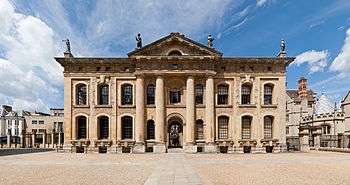Clarendon Building
| Clarendon Building | |
|---|---|
 South elevation of Clarendon Building | |
 Location within Oxford city centre | |
| General information | |
| Type | Office building, former printworks |
| Architectural style | Neoclassical |
| Location | Broad Street, Oxford |
| Coordinates | 51°45′15″N 1°15′16″W / 51.7542°N 1.2545°W |
| Construction started | 1711 |
| Completed | 1715 |
| Owner | University of Oxford |
| Design and construction | |
| Architect | Nicholas Hawksmoor |
| Designations | Listed Grade I |
The Clarendon Building is an early 18th-century neoclassical building of the University of Oxford. It is in Broad Street, Oxford, England, next to the Bodleian Library and the Sheldonian Theatre and near the centre of the city. It was built between 1711 and 1715 and is now a Grade I listed building.[1]
History
Until the early 18th century the printing presses of the Oxford University Press (OUP) were in the basement of the Sheldonian Theatre. This meant that the compositors could not work when the Theatre was in use for ceremonies. The University therefore commissioned a new building to house the OUP.
Nicholas Hawksmoor produced a neoclassical design, construction started in 1711 and it was completed in 1715. The building was funded largely from the proceeds of the commercially successful History of the Great Rebellion by the 1st Earl of Clarendon, whose legacy later paid for the building of the Clarendon Laboratory in Oxford as well.
In the 1820s the OUP moved to new premises in Walton Street, after which the University used the Clarendon Building for administrative purposes. In 1975 the building was transferred to the Bodleian Library, for which it now provides office and meeting space for senior members of staff.[2]
Student occupation
On 22 January 2009 student demonstrators occupied part of the Clarendon Building for seven hours,[3] following similar protests at other UK universities.[4] The demonstrators called for the University to condemn Israel's role in the 2008–2009 Israel–Gaza conflict and to cancel a lecture series at Balliol College inaugurated by Shimon Peres.[3] They ended their protest after an agreement with the Senior Proctor.[5][6]
References
- ↑ Historic England. "The Old Clarendon Building (1185456)". National Heritage List for England. Retrieved 17 December 2014.
- ↑ Jenkins, Stephanie (1 April 2012). "Clarendon Building". Broad Street, Oxford. Retrieved 10 February 2007.
- 1 2 "Gaza sit-in demonstration ended". BBC News Online. 22 January 2009. Retrieved 22 January 2009.
- ↑ Lipsett, Anthea (22 January 2009). "Protests over Gaza spread to eight English universities". guardian.co.uk. Retrieved 22 January 2009.
- ↑ "Statement by the Senior Proctor concerning the occupation of the Clarendon Building". University Administration and Services. University of Oxford. 28 January 2009. Archived from the original on July 25, 2009. Retrieved 29 January 2008.
- ↑ Hood, John (28 January 2009). "Letter from the Vice-Chancellor". Vice-Chancellor's Office. University of Oxford. Archived from the original on July 5, 2009. Retrieved 29 January 2008.
Further reading
- Sherwood, Jennifer; Pevsner, Nikolaus (1974). Oxfordshire. The Buildings of England. Harmondsworth: Penguin Books. pp. 256–257. ISBN 0-14-071045-0.
- Tyack, Geoffrey (1998). Oxford An Architectural Guide. Oxford & New York: Oxford University Press. pp. 150–152. ISBN 0-19-817423-3.
External links
| Wikimedia Commons has media related to Clarendon Building. |
- Sullivan, Mary Ann. "Clarendon Building". Oxford, England. Bluffton University.